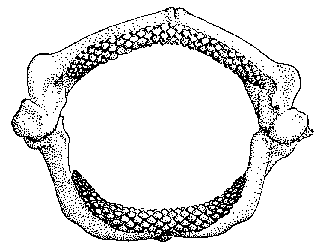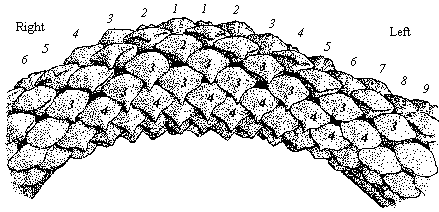 |
probably female, overall width 77 mm |
Jim Bourdon, Scott Greenwald and Henry Mollet
Illustrated by Jim Bourdon, Copyright © 1997
Although not determinable from the illustrations, Nishida and Nakaya provide tooth (file) counts for these dentitions. Based on the examination of eight specimens (6 M, 2 F), they provide the range of 31-39 upper and 33-37 lower.
 |
probably female, overall width 77 mm |
As illustrated, the jaws are 77 mm wide and 58 mm high, the internal width (narrowest) is 48 mm. The upper dental band is 51 mm wide and the lower, 44 mm. The teeth in this dentition compare favorably with a female specimen at the Monterey Bay Aquarium.
The medial teeth have a traditional dasyatid (male) cuspidate (grasping) crown which is derived from an elongated cusp, rising from the lower crown and directed lingually. Viewed labially, these teeth have a distinctly pointed crown.
The lateral teeth, however, do not have the globular crown of a crushing dentition as is present in most stingrays. The labio-lingually compressed upper regions of the crown has produced a high, usually (meso-distally) elongated, transverse crest -- a cutting dentition. The crest is enhanced by enameloid ridges which would produce a serrate-like cutting edge. Certain anterior lateral teeth may be cuspidate when viewed labially.
 |
Files: right 7 -- left 9, Series: 2 - 5, illustrated width 26 mm, labial to top |
Cusps. For upper teeth, files #1 - 3/4 are high-cusped, files #4/5 - 7 low-cusped. In the lower teeth, files #S - 1 are high-cusped, 2-7 are low-cusped. The remaining files for each dental band, have a high transverse ridge which begin with a cusp-like apical angle in position #8 and gradually decrease in height distally.
File Groups For the purposes of this report, these files have been segregated into two groups, medial and lateral.
Medial teeth [files S(1) - 7]. In this dentition, these are the cusp bearing crowns and are of similar size (2.9 - 3.0 mm in width and about 2 mm in depth) although the symphyseal and file #1 are slightly narrower (laterally compressed).
Lateral teeth. In the upper dental band, U8 - 11 are the broadest teeth of the dentition, measuring to 3.3 mm in width. Beginning with U12 (2.9 mm) the teeth diminish in width to U17 (2.0 mm). In the lower band, L8 - L9 are 2.6 - 2.8 mm in width, U10 (2.4 mm) and continuing to narrow to U19 (1.8/2.0 mm).
Although few teeth could be measured properly, several removed teeth show a significant labio-lingual compression of the lateral teeth distally. Selected width x depth measurements include: UL5: 3.0 x 1.8, UR10: 3.3 x 1.9, UR15: 2.4 x 1.5 and LL5: 3.0 x 2.1, LR10: 2.4 x 1.8 and LR15: 2.2 x 1.3 mm.
Functional Teeth. In this dentition, the "first" (labial most) upper series is in the process of being shed, and the second appears functional. In the lower teeth, the second series appears worn and the third appears to be the primary functional series.
Tooth Wear: The series being shed showed no evidence of the cusps which were visible on the functional and replacement teeth. [A fossil tooth would likely not reveal the cuspidate design of these teeth.]
Bicuspidate Several teeth show evidence of a bicuspidate condition. In this dentition they were relegated to files 4 - 8. This condition was noted in replacement series (as high has series 7) suggesting this is not a wear condition but an odontological characteristic of the species.
| Goto to: | Pelagic Stingray Home Page, | Shed Teeth, | Denticles |
| Shed Rates & Sampling, | Reference Material | Glossary |
Page revised May 26, 1997